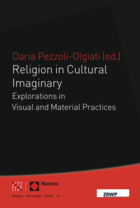In 2011, the research network Religious Images and Cultural Imaginaries started to meet for regular seminars to discuss the central question to what extent the category “imaginary” might be a helpful heuristic tool to engage with the complexity and plurality of meanings and meaning-making processes in society. In particular, we are interested in how the concept may help to understand the presence and intentional use of religious elements in culture and how they are received and understood.
The results of our research have just been published – and you can find the TOC and abstracts here. Whilst each paper focuses upon a particular case study, this common question is also reflected upon (at a more theoretical level). Each paper discusses how “imaginary” is used and its usefulness for the particular case study in question, and on the basis of these case-studies it will be possible to trace common mechanisms and processes by which the imaginary works (in a descriptive sense). Theories of the imaginary are being introduced and serve as background, but do not limit our approach or use of the concept.
The main issues of our discussions – and thus of our publication – evolve around the following themes:
- Reconstructing the history of the term and the main lines of research in the use of the concept of the imaginary.
- Characterising the different theories of the imaginary and their particular contribution to academic research.
- Using a “map of the imaginary”, afforded a methodological and epistemic function, to outline the different relationships to other key terms in the study of religion.
- Defining the relationship between image, imagination and imaginary.
- Using the terminology “cultural imaginary” as a basic, general, all-encompassing term in preference to “social/religious/moral/political imaginary”. The latter adjectives denote a more specific usage that can be used and defined for the purposes of individual papers, where necessary.
- Stressing the crucial significance of intermediality and the particular function of visual media.
